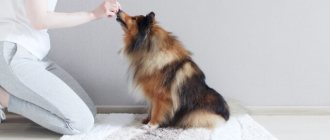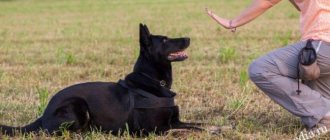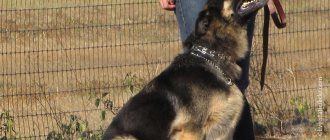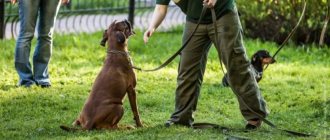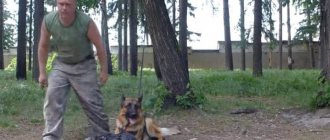(Photo credit: merc67/Getty Images)
January marks the official start of the national dog training month, but you can teach your dog new things at any time of the year. We all love our pets, but sometimes it may seem like your dog is incapable of learning any tricks. Although it may feel impossible, with the right techniques and the right amount of practice it's just something any dog can learn.
Taking on teaching your dog some tricks is a great New Year's resolution, but it's also a fun bonding experience for you and your dog throughout the year. Watch the following video to learn some simple techniques that make it possible for any dog to learn tricks.
Bark On Command
This trick may be for more experienced dogs and takes some extra patience as it is one of the more difficult tricks. As the video shows, you have to be diligent in waiting for your dog to bark at you first, and then reward them as they constantly do. The dog in the video won't bark right away even if the trainer is a professional, so make sure you remember that this won't happen right away. However, if you can master it, barking on command is a very unique trick that will definitely amaze your fellow dog owners.
Kiss
The simplest, albeit “slobbery” trick is “Kiss” or “Kiss Mom”. Let your dog sniff the treat. Sit the animal frontally (in front of you), step on the leash with one foot so that the pet cannot make a sharp jerk. Give the command “Kiss”, hold the treat between your lips and lean towards the dog. Be careful and restrain your pet with a leash; you want your dog to gently take the treat rather than grab it with his teeth. While practicing the skill, allow the animal to place its paws on your chest.
Shake hands
The “shake hand” trick is definitely one of the cuter tricks your puppy can learn. It's quite simple and is actually one of the easiest tricks to teach. The secret is that your dog will already naturally put his paw on you if they want something. When you present a closed handful of treats, your pet will be forced to paw on your hand since they cannot treat with their mouth. As soon as they continue pawing, start using the command “Give paw” and repeating it several times, your dog is sure to learn a new trick.
Spin around
To perform it, you need to take your favorite treat and use it to describe an imaginary circle in the air. You need to ensure that the dog turns around freely. Initially, you need to get the dog to spin in different directions. After several trainings, the free circle is narrowed, ensuring that the animal begins to spin in a certain zone.
Bring
And fetch is a classic game; for some dogs it's deception, which doesn't come naturally. It can get quite frustrating when your dog doesn't cooperate during playtime. Some dogs are not interested in toys and don't even want to try, some will go and fetch the toy but won't return it, and then there are stubborn dogs that will bring the toy back but then won't let go. Watch this tutorial to see how you can get your dog interested in fetch in the first place, and then actually learn how to play fetch correctly.
Bow
A body position that pets often adopt on their own when stretching or playing with their relatives. The dog that follows the command stands on its hind legs and lies on its front legs. The starting position is at the left foot. We step on the leash with our left foot, and with our right hand we move the treats away from the nose, forward and down. We provoke the pet to lie down without giving the command “Lie down”. As soon as the ward begins to stretch out his front paws, we put our left hand under the stomach, restraining the reflex forward movement, and give the command “Bow.” At the initial stage, even a slight tilt of the dog’s body is considered successful execution of the command.
Play Dead
“Playing Dead” is a great trick that is sure to impress your friends and families. Unlike simple commands such as sit or shake hands, playing dead takes a little more time and persistence to master. This tutorial uses the reverse approach, teaching the last part of the trick first for the dog to learn more easily. Take your time and remember to reinforce with a clicker and treats to make the process faster. If your dog already knows the “roll over” trick, then it will be much easier for them to learn this trick.
"Snake"
This trick is easier and better to teach dogs of medium and toy breeds. To teach this interesting command, you need to take a fairly wide step, say the command “Snake” and stick your hand with a clamped treat under your knee, while simultaneously beckoning the animal. The dog should pass under the knee diagonally. Next, take the next step, finishing the exercise. In the initial stages, 2-3 steps will be enough.
Back
Getting your dog on his back on command is one of the main dog pranks. Although seemingly difficult, doing your dog's back when directed can be done very easily with the right technique. The instructor in the video shows you how to start with a treat and eventually get just a voice command. However, getting your dog on his back with a voice command alone can be quite difficult for newbies, so even if you get your dog on his back with a hand, cue or treat, then it is still an achievement to be celebrated.
Principles of training in the circus
The main difference between circus training and regular training with a trainer is the predominance of the taste-based method, which is based on the positive encouragement of the trained animal with a treat. If before working on the big stage the dog was trained in a different way, then it will be extremely difficult to retrain it.
Already from the first minute of the performance of the four-legged people, a person with an experienced eye can determine how the animals were engaged. If the animals are energetic, follow commands with interest and the first time, the training went well. Otherwise, if the animals perform tasks sluggishly, and the trainer has to repeat commands, then most likely the training process was structured incorrectly or the pets did not receive enough encouragement during the classes.
In order for the skill development process to be as productive as possible, the following training rules must be observed:
- a dog no older than 2-3 months;
- contact with an animal before starting classes;
- knowledge of basic commands from the training course;
- great desire and patience of the teacher;
- availability of free time.
As a rule, training begins with 1.5-month-old puppies, and after a few weeks the pets easily execute the commands: “lie down,” “fu,” “fetch,” “sit,” and “come.”
With age, the puppy learns to carry out new commands aimed at performing on the big stage: “barrier”, “stand”, “place”, “forward”, “nearby”. The main thing in establishing a skill is regularity, not duration. If you devote 20 minutes to training every day, this will be enough for your pet to learn how to perform simple numbers.
Special competitions are held in Moscow where dogs show circus skills. If you want to take part, you will need to work with your dog for about an hour every day for a long time - up to six months. During training, they usually learn tricks: dancing and twirling, bowing, passing between the legs, walking backwards.
Which numbers to choose for your pet is up to you. These can be complex performances or just a couple of exercises from a basic training course.
Sit Pretty
Making your dog “sit pretty” isn't just fun because it gives you a chance to take cute photos of your puppy to post on Instagram, but it's also great exercise for your dog. Making your dog kick is an adorable pose that helps with your dog's balance and can build core muscles. However, make sure your dog is healthy for this trick because it can be stressful for dogs with pre-existing conditions.
General principles of animal training
Hypoallergenic cats: list of main breeds
The meaning of human words is incomprehensible to small puppies, but they are able to associate the owner’s intonations with his mood. Therefore, a puppy who makes a puddle on the floor instead of a diaper or toilet, and at the same moment receives a menacing shout from the owner, will quickly learn that he did something bad.
Praise given in a calm, soft voice and at the right time will let the baby know what to do. Accustoming to useful skills should be encouraged by stroking or favorite treats, which are given immediately after the command is executed.
Dogs gradually become accustomed to human words and gestures indicating commands. The owner and the pet must be patient and consistent. You cannot allow an animal today what was prohibited yesterday and vice versa. A grown-up dog will not be able to understand why he cannot sleep next to his owner or beg in the kitchen if he did this while he was a puppy.
The puppy is taught the command “Give me a paw”
The result of training will depend on how responsibly the owner of the animal will adhere to the principles of the command learning process:
- first a command is given, the animal carries it out, and then a quick reward follows;
- if the animal does not execute a one-time command, it cannot be repeated a second time; the dog should be forced with a leash or hand to carry out the command;
- When giving a command, you should not add accompanying words, for example, “quick voice” instead of “voice”;
- the words denoting the command must be uniform. The verbs “lie down and stand” should not replace commands included in the mandatory list for domestic dogs, such as “Lie down” and “Stand”;
- commands must be pronounced clearly, loudly, but without shouting;
- The dog needs to be trained in a calm environment and in conditions that are interesting for the pet.
Note! It is in the genes of dogs to obey the leader of the pack. It is important to make the animal realize that in the human pack it is in last place after a small child and a weak grandmother.
Why do you need to train a dog?
The set of commands for non-service dogs can be very diverse. Some owners ask their four-legged friend to bring slippers, others command “Guard!”, and still others teach the pet to bow. Dogs are highly trainable and can learn a wide range of skills.
Of course, the first need for learning commands is education. The dog must understand the prohibition and perform the simplest actions so that the whole family can live comfortably with their four-legged pet.
The second most important reason is discipline. When training, the dog is placed one step lower than the person and understands that she is not a leader. This forms obedient, but at the same time respectful behavior of the animal.
The third reason is that if a dog was bred for specific purposes (watchman, guide, companion, hunter), it must be able to carry out specific commands. They are usually learned under the guidance of an experienced trainer.
Additional, so to speak, bonus benefits include having fun together between the owner and the four-legged dog. Both learn to understand and respect each other, a rapprochement occurs and a strong friendship develops.
"Kiss"
Many pets, demonstrating their affection for their owner, tend to lick him on the nose or cheek. This impulse can be used to teach the “kiss” command.
Say the command every time your dog is about to lick you. Praise and/or treat your pet every time after this, and do not encourage licking without a command. After several repetitions, the dog should learn the command.
The second option is suitable for calm dogs, not prone to sudden, careless movements. At the same time as the command, bringing your face closer to your pet, hold a piece of treat to the cheek so that the dog can grab it or lick it. With each repetition, reduce the piece of treat, and then completely remove your hand from your cheek.
Possible harm and contraindications
While this technique has more than enough healing and strengthening effects, contraindications also exist, and they are so strict that it would be more correct to call them absolute prohibitions.
- It is forbidden for women to perform any of the inverted poses during the menstrual cycle
(during menstruation). In hatha yoga, this is explained by a simple argument - “there is no need to disrupt the natural flow of cleansing of the body, which naturally rushes down towards the earth.” Even traditional medicine confirms that such disorders are fraught with dangerous bleeding. This prohibition is also confirmed in religions, since women are not allowed to begin the prayer ritual during this period until purification. - It is dangerous to perform this movement for those who suffer from high or low blood pressure,
due to the danger of a sharp rise in pressure. - Contraindicated for those suffering from glaucoma and increased intraocular pressure.
- For people diagnosed with chronic asthma
or during periods of its seasonal manifestations, the Head Down Dog exercise is also not recommended due to the possibility of breathing problems.
You should ask directly either your doctor or instructor about other possible contraindications if you have concerns about a particular disease. In general, Adho mukha svanasana is available to almost every person who decides to master the technique of “inverted view of the world”, thanks to its many lightweight options. The main thing is patience, self-confidence and daily effort.

